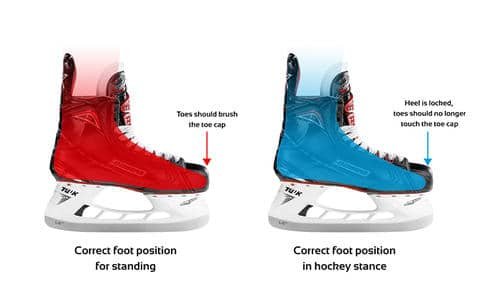Buying hockey skates can be confusing. There are many options and features to consider.
Finding the right pair is crucial for comfort and performance on the ice. In this guide, you will learn how to choose the best hockey skates. Whether you are a beginner or a seasoned player, the right skates can make a big difference.
We will cover everything you need to know. From understanding different types of skates to finding the right fit, you will be well-prepared to make an informed decision. Knowing what to look for can save you time and money. Get ready to find the perfect skates and improve your game.

Credit: www.purehockey.com
Choosing The Right Type
Choosing the right type of hockey skates is crucial for comfort and performance. Each type of skate has specific features. These features cater to different levels of play and surfaces. Understanding these differences will help you make a better choice.
Recreational Vs. Competitive
Recreational skates are designed for casual play. They offer good comfort and protection. They are ideal for beginners or those who skate occasionally. Competitive skates, on the other hand, are built for serious players. They provide better support and performance. They are more durable and often more expensive. Choose based on your level of play and needs.
Inline Vs. Ice Skates
Inline skates have wheels aligned in a single row. They are perfect for outdoor play or training. They offer good speed and maneuverability. Ice skates have a blade instead of wheels. They are used on ice surfaces. They provide better control and stability on ice. Decide based on where you will skate most often.
Measuring Your Feet
Choosing the right hockey skates starts with measuring your feet correctly. Proper measurements ensure a comfortable fit and better performance on the ice. In this section, we will guide you through the process of measuring your feet for hockey skates.
Length And Width
First, measure the length of your feet. Use a ruler or a measuring tape. Place your foot on a flat surface with your heel against a wall. Measure from the heel to the tip of your longest toe. Record this length in inches or centimeters.
Next, measure the width of your feet. Wrap the measuring tape around the widest part of your foot. Usually, this is across the ball of your foot. Make sure the tape is snug but not too tight. Record this measurement as well.
Brannock Device Guide
A Brannock Device can help you get accurate foot measurements. This tool is often used in shoe stores. It measures both the length and width of your feet. Place your foot on the device and follow the instructions. Make sure to measure both feet, as they might be different sizes.
Using a Brannock Device ensures precise measurements. This helps you find the best-fitting hockey skates. Accurate measurements are crucial for comfort and performance.
Understanding Skate Sizing
Choosing the right size for hockey skates is crucial. Properly fitting skates improve performance and comfort. Knowing your size helps prevent blisters and foot pain. Understanding skate sizing involves a few key factors.
Youth Vs. Adult Sizes
Hockey skates come in youth and adult sizes. Youth sizes are for children, while adult sizes fit older teens and adults. Youth skates are smaller and have different sizing charts. Adult skates start at size 6 and go up. Youth sizes are numbered differently, starting from size 1.
Conversion Charts
Skate sizes differ from regular shoe sizes. Using a conversion chart helps find the right skate size. Conversion charts compare shoe sizes to skate sizes. They show the equivalent skate size for each shoe size. Measure your foot length to use the chart effectively. This ensures you get a snug fit for your skates.

Credit: hockeysupremacy.com
Trying On Skates
Trying on hockey skates is a crucial step in finding the perfect pair. Ensuring a proper fit can enhance your performance and comfort on the ice. This section will guide you through the essential steps to try on skates effectively.
Lacing Techniques
Proper lacing techniques can make a big difference in how your skates fit. Follow these steps:
- Loosen the laces: Start by loosening the laces from the top to the bottom. This will make it easier to slide your foot into the skate.
- Secure the toe area: Once your foot is in, pull the laces tight around the toe area. This ensures a snug fit and keeps your foot in place.
- Move up the eyelets: Continue to tighten the laces as you move up the eyelets. Make sure each section is snug but not too tight. You want to maintain good circulation.
- Lock the ankle: When you reach the top, tie the laces securely to lock your ankle in place. This provides the needed support for skating.
Checking The Fit
Ensuring that the skates fit well is essential for comfort and performance. Here are some tips:
- Toe Cap Test: With the skate laced, your toes should barely touch the toe cap. They should not be cramped.
- Heel Test: Your heel should stay in place when you walk. There should be minimal movement.
- Width Check: The sides of your feet should feel snug without squeezing. You should not feel any pinching or pressure points.
- Flex Test: Bend your knees and flex your ankles. The skate should move with your foot without any discomfort.
By following these steps, you can ensure that your hockey skates fit well and provide the support and comfort you need on the ice. Happy skating!
Skate Features To Consider
When buying hockey skates, consider several features to find the best fit. These features impact performance and comfort. Knowing what to look for can help you make an informed decision.
Blade Quality
The blade is a crucial part of the hockey skate. High-quality blades ensure better control on the ice. Stainless steel is a popular choice for its durability. It resists rust and holds an edge longer. Regularly sharpen your blades to maintain their performance. The blade profile, or shape, affects your skating style. Some profiles offer better speed, while others provide more stability.
Boot Material
The boot material impacts the skate’s weight and support. Traditional leather boots offer a snug fit and good support. Modern skates often use synthetic materials. These materials are lighter and can be more durable. A stiff boot provides better ankle support. This is vital for quick turns and stops. A well-padded boot ensures comfort during long games. Custom fit options are available for a personalized feel. Consider your skill level and playing style when choosing boot material.

Credit: www.youtube.com
Frequently Asked Questions
How Do I Choose The Right Hockey Skates?
Choose skates based on fit, comfort, and your skill level. Try different brands.
What Size Hockey Skates Should I Buy?
Hockey skates are usually 1-1. 5 sizes smaller than your shoe size. Measure your foot.
How Much Do Hockey Skates Cost?
Hockey skates range from $50 to $900. Prices depend on brand, quality, and features.
What Are The Best Brands For Hockey Skates?
Popular brands include Bauer, CCM, and Reebok. Each offers different features and fits.
How Often Should I Replace Hockey Skates?
Replace skates every 2-3 years or when they become uncomfortable or damaged.
Can I Bake My Hockey Skates At Home?
Yes, you can bake skates at home to improve fit. Follow the brand’s instructions carefully.
How Do I Break In New Hockey Skates?
Wear them at home or during practice. Use skate guards and avoid getting them wet.
What Is The Difference Between Ice And Inline Hockey Skates?
Ice skates have a blade for ice. Inline skates have wheels for smooth surfaces.
How Do I Maintain My Hockey Skates?
Dry them after each use. Sharpen the blades regularly. Check for any damage frequently.
Conclusion
Choosing the right hockey skates can greatly impact your performance. Focus on fit, comfort, and durability. Try on several pairs to find the best match. Pay attention to the skate’s material and support features. Proper care extends their lifespan. Investing time in your selection pays off on the ice.
Now you’re ready to make an informed purchase. Enjoy your skating journey!




